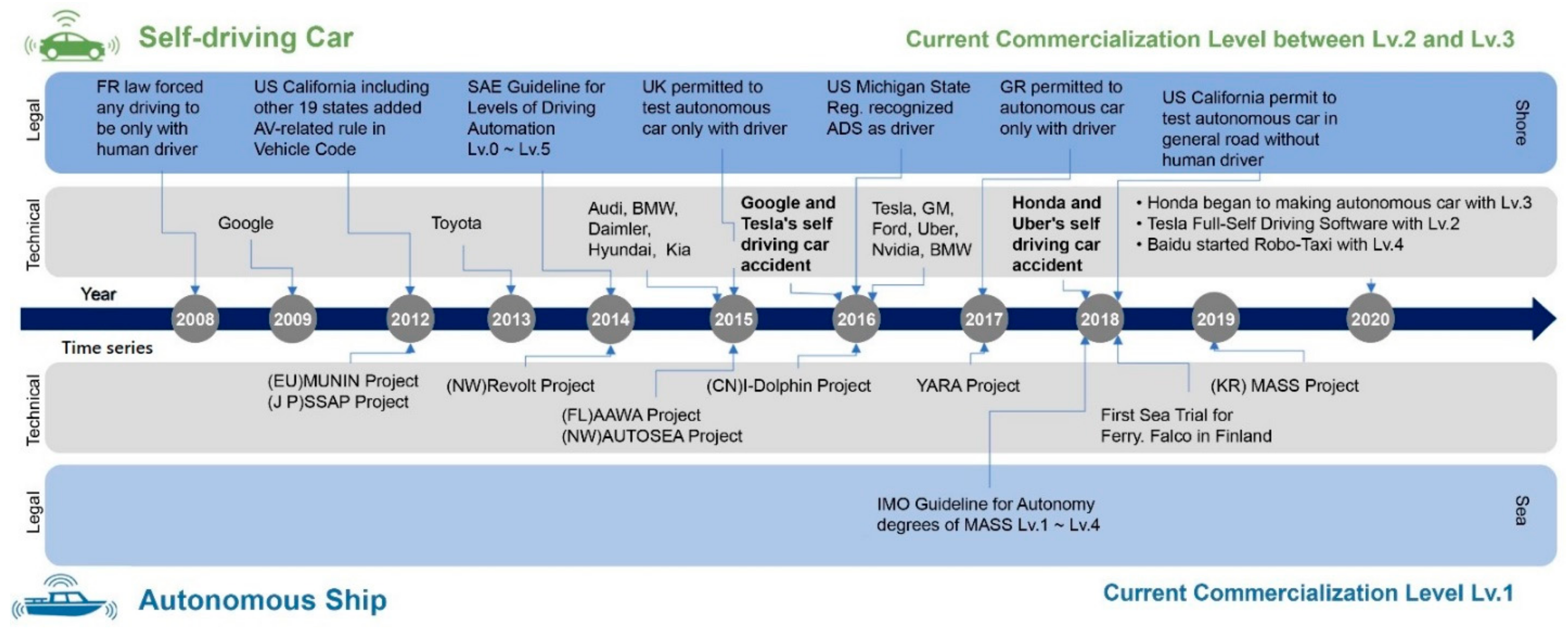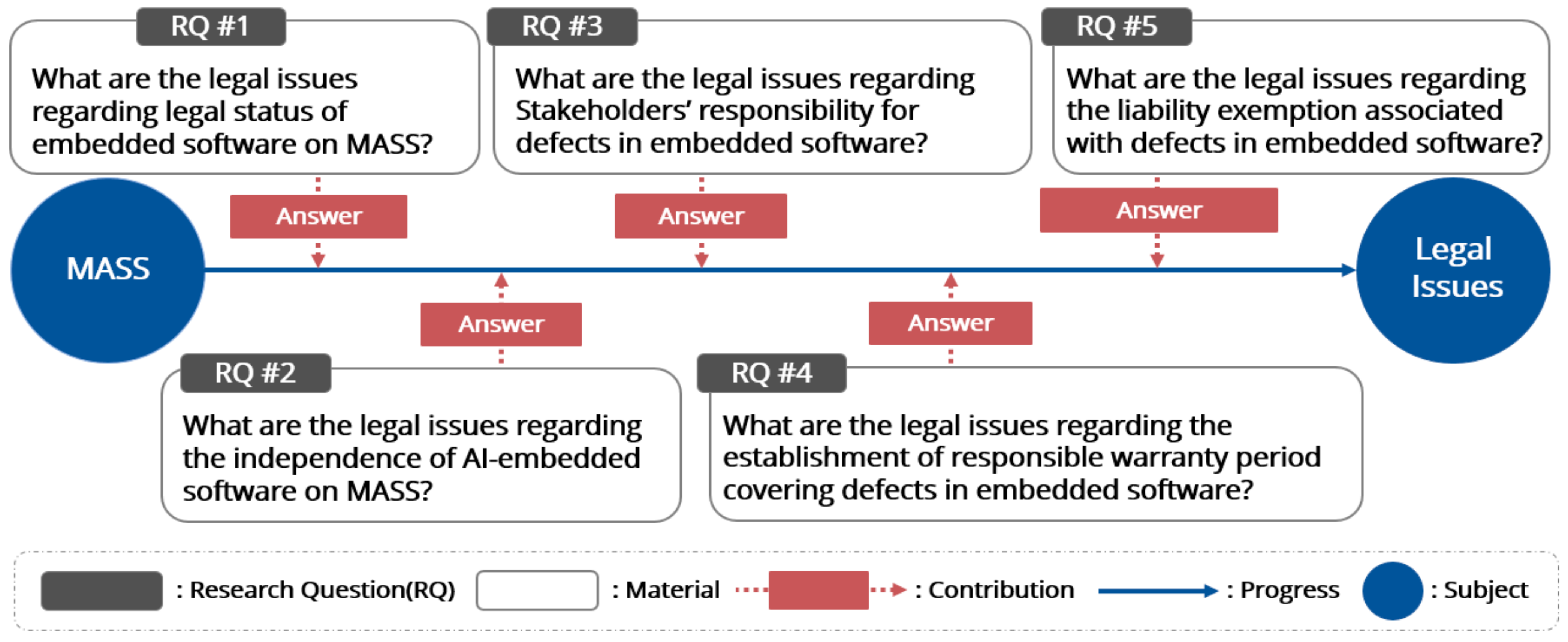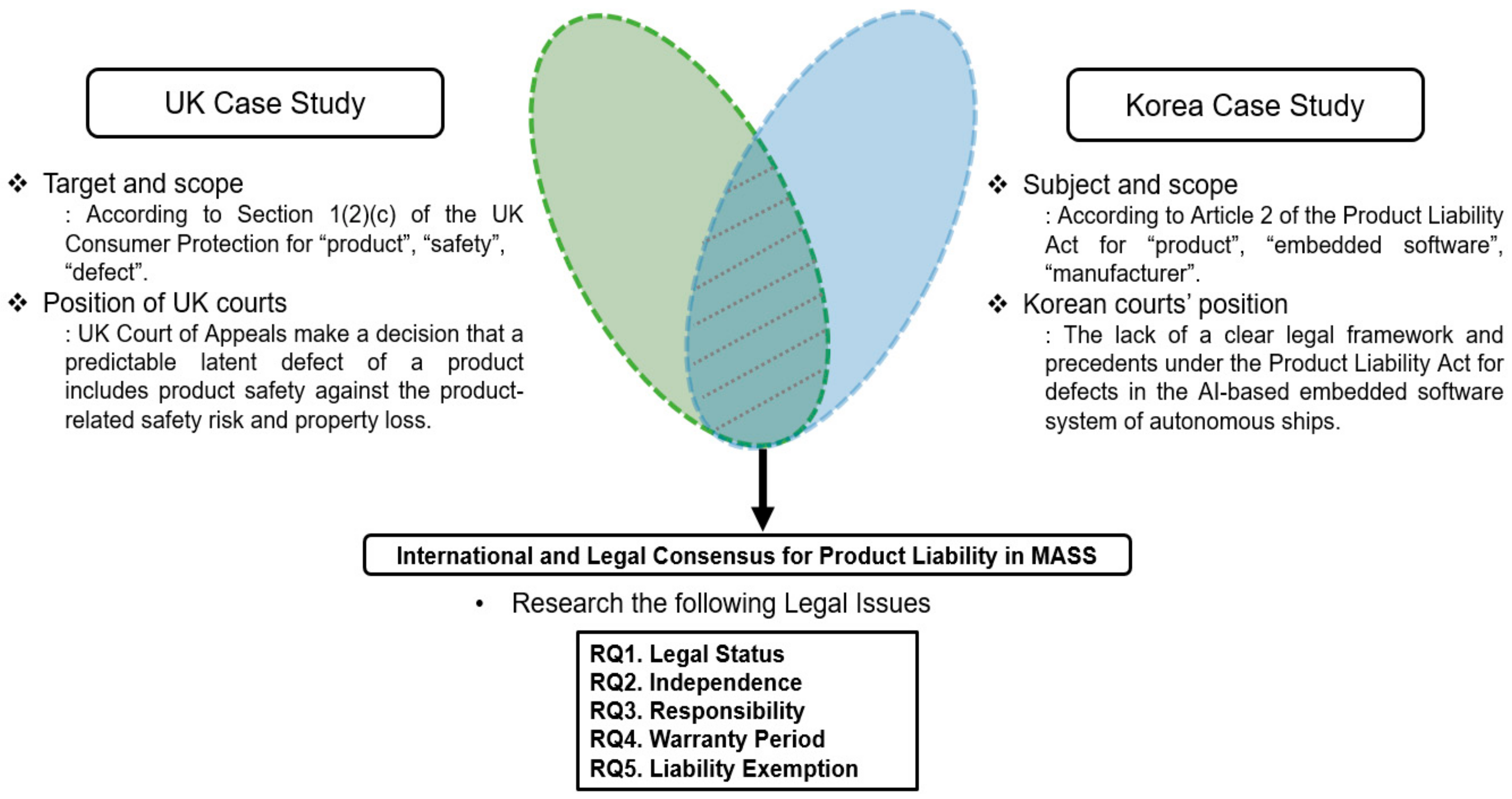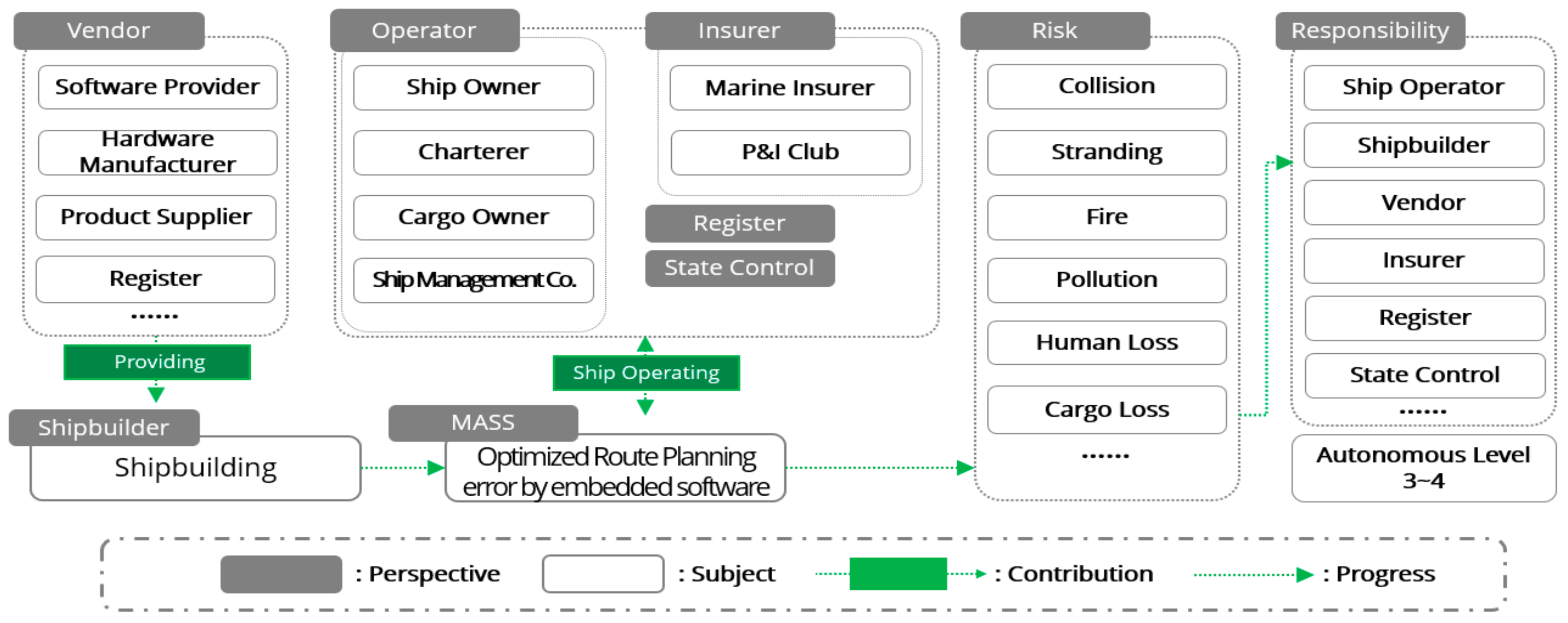Potential Liability Issues of AI-Based Embedded Software in Maritime Autonomous Surface Ships for Maritime Safety in the Korean Maritime Industry
Abstract
:1. Introduction
1.1. Background of the Study
1.2. Research Aim
1.3. Current Issues and Research Questions
1.4. Literature Review
2. Research Theory and Methods
2.1. Theory
2.1.1. Korea’s Product Liability Act and Its Application to Autonomous Ships
2.1.2. The UK Product Liability Act and Its Application to Autonomous Ships
2.2. Dual Comparison Method
3. Results
3.1. Korea
3.1.1. Subjects and Scope
3.1.2. Korean Courts’ Position on Product Liability
3.2. The United Kingdom
3.2.1. Target and Scope
3.2.2. Position of UK Courts on Product Liability
4. Potential Issues in Embedded Software Defects in the Age of Autonomous Ships
4.1. Advancement to RQ No. 1
4.2. Advancement to RQ No. 2
4.3. Advancement to RQ No. 3
4.4. Advancement to RQ No. 4
4.5. Advancement to RQ No. 5
5. Discussion
6. Conclusions
Author Contributions
Funding
Institutional Review Board Statement
Informed Consent Statement
Data Availability Statement
Conflicts of Interest
References
- Petrig, A. Unmanned Offender and Enforcer Vessels and the Multi-Dimensional Concept of ‘Ship’ under the United Nations Convention on the Law of the Sea. In UNCLOS as a System of Regulation, 1st ed.; Kristina, S., Fenella, B., Birgit, F., Eds.; Routledge: London, UK, 2021. [Google Scholar]
- IMO Takes First Steps to Address Autonomous Ship. Available online: https://www.imo.org/en/MediaCentre/PressBriefings/Pages/08-MSC-99-MASS-scoping.aspx (accessed on 15 January 2022).
- Autonomous Ships: Regulatory Scoping Exercise Completed. Available online: https://www.imo.org/en/MediaCentre/PressBriefings/pages/MASSRSE2021.aspx (accessed on 15 January 2022).
- Porathe, T. A Navigating navigator onboard or a monitoring operator ashore? Towards safe, effective, and sustainable maritime transportation: Findings from five recent EU projects. Transport. Res. Proc. 2016, 14, 233–242. [Google Scholar] [CrossRef] [Green Version]
- Kretschmann, L.; Burmeister, H.C.; Jahn, C. Analyzing the economic benefit of unmanned autonomous ships: An exploratory cost-comparison between an autonomous and a conventional bulk carrier. Res. Transp. Bus. Manag. 2017, 25, 76–86. [Google Scholar] [CrossRef]
- Ramos, M.A.; Utne, I.B.; Vinnem, J.E.; Mosleh, A. Accounting for Human Failure in Autonomous Ship Operations. In Safety and Reliability—Safe Societies in a Changing World, 1st ed.; Haugen, S., Barros, A., van Gulijk, C., Kongsvik, T., Vinnem, J.E., Eds.; CRC Press: London, UK, 2018. [Google Scholar] [CrossRef]
- Rodseth, O.J. From concept to reality: Unmanned merchant ship research in Norway. In Proceedings of the Underwater Technology (UT), Busan, Korea, 21–24 February 2017; p. 10. [Google Scholar] [CrossRef]
- Chang, Y.; Zhang, C.; Wang, N. The international legal status of the unmanned maritime vehicles. Marine Policy 2020, 113, 103830. [Google Scholar] [CrossRef]
- Schmitt, M.N.; Goddard, D.S. International law and the military use of unmanned maritime systems. Int. Rev. Red Cross 2016, 98, 567–592. [Google Scholar] [CrossRef]
- Rothblum, A.M. Human Error and Marine Safety, National Safety Council Congress and Expo, Orlando. 2000. Available online: http://www.bowles-langley.com/wp-content/files_mf/humanerrorandmarinesafety.pdf (accessed on 8 March 2021).
- Utne, I.B.; Sorensen, A.J.; Schjolberg, I. Risk management of autonomous marine systems and operations. In Proceedings of the International Conference on Offshore Mechanics and Arctic Engineering, Hamburg, Germany, 5–10 June 2017; pp. 1–10. [Google Scholar] [CrossRef]
- Fan, C.; Wróbel, K.; Montewka, J.; Gil, M.; Wan, C.; Zhang, D. A framework to identify factors influencing navigational risk for Maritime Autonomous Surface Ships. Ocean. Eng. 2020, 202, 107188. [Google Scholar] [CrossRef]
- Wrobel, K.; Montewka, J.; Kujala, P. Towards the assessment of potential impact of unmanned vessels on maritime transportation safety. Reliab. Eng. Syst. Saf. 2017, 165, 155–169. [Google Scholar] [CrossRef]
- Ringbom, H.; Rosaeg, E.; Solvang, T. Autonomous Ships and the Law, 1st ed.; Routledge: London, UK, 2020. [Google Scholar]
- Coito, J. Maritime Autonomous Surface Ships: New Possibilities—and Challenges—in Ocean Law and Policy. Int. Law Stud. 2021, 97, 259–306. [Google Scholar]
- Ghaderi, H. Autonomous technologies in short sea shipping: Trends, feasibility and implications. Transp. Rev. 2018, 39, 152–173. [Google Scholar] [CrossRef]
- Caccia, M. Autonomous surface craft: Prototypes and basic research issues. In Proceedings of the 14th Mediterranean Conference on Control and Automation, Ancona, Italy, 28–30 June 2006; pp. 1–6. [Google Scholar] [CrossRef] [Green Version]
- Liu, Z.; Zhang, Y.; Yu, X.; Yuan, C. Unmanned surface vehicles: An overview of developments and challenges. Annu. Rev. Control 2016, 41, 71–93. [Google Scholar] [CrossRef]
- Comite Maritime Internation Position Paper on Unmanned Ships. Available online: https://comitemaritime.org/wp-content/uploads/2018/05/CMI-Position-Paper-on-Unmanned-Ships.pdf (accessed on 1 November 2021).
- Ringbom, H.M.; Veal, R. Unmanned ships and the international regulatory framework. J. Int. Marit. Law 2017, 23, 100–118. [Google Scholar]
- Uzair, M. Who is liable when a driverless car crashes? World Electr. Veh. J. 2021, 12, 62. [Google Scholar] [CrossRef]
- Li, S.; Fung, K.S. Maritime Autonomous Surface Ships (MASS): Implementation and legal issues. Marit. Bus. Rev. 2019, 4, 330–339. [Google Scholar] [CrossRef] [Green Version]
- Vojkovic, G.; Milenkovic, M. Autonomous Ships and Legal Authorities of the Ship Master. Case Stud. Transp. Policy 2020, 8, 333–340. [Google Scholar] [CrossRef]
- Nava, G.; Fernanda, P.M. Legal Challenges of Liability in Collisions Arising from the Development of Autonomous and Unmanned Shipping—International and Norwegian Perspective. Master’s Thesis, University of Oslo, Oslo, Norway, 2019. [Google Scholar]
- Chamberlain, A.; Colaco, H. The Shipping Law Review: United Kingdom—England & Wales. Law Revs 8 June 2021. Available online: https://thelawreviews.co.uk/title/the-shipping-law-review/united-kingdom-england--wales (accessed on 1 November 2021).
- Jae-Seon, S.; Jung-Eun, S. Product liability in Korea. In Product Liability: Fundamental Questions in a Comparative Perspective; Koziol, H., Green, M.D., Lunney, M., Oliphant, K., Yang, L., Eds.; De Gruyter: Berlin, Gemany, 2017; pp. 80–96. [Google Scholar] [CrossRef]
- Beard, T.R.; Ford, G.S.; Koutsky, T.M.; Spiwak, L.J. Tort liability for software developers: A law & economics perspective. J. Marshall J. Comput. Inf. Law 2009, 27, 199. [Google Scholar]
- MUNIN. Research in Maritime Autonomous Systems Project Results and Technology Potentials. 2016. Available online: http://www.unmanned-ship.org/munin/wp-content/uploads/2016/02/MUNIN-final-brochure.pdf (accessed on 20 January 2022).
- Alfheim, H.; Muggerud, K. Development of a Dynamic Positioning System for the ReVolt Model Ship. Master Thesis, Norwegian University of Science and Technology, Trondheim, Norway, June 2017. Available online: https://ntnuopen.ntnu.no/ntnu-xmlui/bitstream/handle/11250/2452115/16486_FULLTEXT.pdf (accessed on 20 January 2022).
- Kongsberg, Autonomous Ship Project, Key Facts about YARA Birkeland. 2017. Available online: https://www.kongsberg.com/maritime/support/themes/autonomous-ship-project-key-facts-about-yara-birkeland (accessed on 11 March 2022).
- NYK Line. NYK Conducts World’s First Maritime Autonomous Surface Ships Trial. 2019. Available online: https://www.nyk.com/english/news/2019/20190930_01.Html (accessed on 11 March 2022).
- Lee, M.C.; Nieh, C.Y.; Kuo, H.C.; Huang, J.C. An automatic collision avoidance and route generating algorithm for ships based on field model. J. Mar. Sci. Technol. 2019, 27, 101–113. [Google Scholar] [CrossRef]
- Song, R.; Liu, Y.; Bucknall, R. A multi-layered fast marching method for unmanned surface vehicle path planning in a time-variant maritime environment. Ocean Eng. 2017, 129, 301–317. [Google Scholar] [CrossRef]
- Ramos, M.A.; Utne, I.B.; Mosleh, A. Collision avoidance on maritime autonomous surface ships: Operators’ tasks and human failure events. Saf. Sci. 2019, 116, 33–44. [Google Scholar] [CrossRef]
- Chang, C.H.; Kontovas, C.; Yu, Q.; Yang, Z. Risk assessment of the operations of maritime autonomous surface ships. Reliab. Eng. Syst. Saf. 2021, 207, 107324. [Google Scholar] [CrossRef]
- Carey, L. All hands off deck? The legal barriers to autonomous ships. In NUS Centre for Maritime Law Working Paper 17/06; Centre for Maritime Law (CML): Singapore, 2017; p. 8. [Google Scholar] [CrossRef]
- Ferreira, F.; Alves, J.; Leporati, C.; Bertolini, A.; Bargelli, E. Current regulatory issues in the usage of autonomous surface vehicles. In Proceedings of the OCEANS—MTS/IEEE Kobe Techno-Oceans (OTO), Kobe, Japan, 28–31 May 2018; pp. 1–9. [Google Scholar] [CrossRef]
- Giunta, L. The enigmatic juridical regime of unmanned maritime systems. In OCEANS 2015-Genova; IEEE: New York, NY, USA, 2015; pp. 1–9. [Google Scholar] [CrossRef]
- Showalter, S.; Manley, J. Legal and engineering challenges to widespread adoption of unmanned maritime vehicles. In OCEANS; IEEE: New York, NY, USA, 2009; pp. 1–5. [Google Scholar] [CrossRef]
- Kuwata, Y.; Wolf, M.T.; Zarzhitsky, D.; Huntsberger, T.L. Safe maritime autonomous navigation with COLREGs, using velocity obstacles. IEEE J. Ocean. Eng. 2014, 39, 110–119. [Google Scholar] [CrossRef]
- Benjamin, M.R.; Curcio, J.A. COLREGS-based navigation of autonomous marine vehicles. In 2004 IEEE/OES Autonomous Underwater Vehicles (IEEE Cat. No. 04CH37578); IEEE: New York, NY, USA, 2004; pp. 32–39. [Google Scholar] [CrossRef]
- Felski, A.; Zwolak, K. The ocean-going autonomous ship—Challenges and threats. J. Mar. Sci. Eng. 2020, 8, 41. [Google Scholar] [CrossRef] [Green Version]
- Delvaux, M.; Mayer, G.; Boni, M. Report with Recommendations to the Commission on Civil Law Rules on Robotics, European Parliament. 2017. Available online: https://www.europarl.europa.eu/doceo/document/A-8-2017-0005_EN.pdf (accessed on 1 November 2021).
- Leenes, R.; Palmerini, E.; Koops, B.J.; Bertolini, A.; Salvini, P.; Lucivero, F. Regulatory challenges of robotics: Some guidelines for addressing legal and ethical issues. Law Innov. Technol. 2017, 9, 1–44. [Google Scholar] [CrossRef] [Green Version]
- Collin, F. Maritime Product Liability at the Dawn of Unmanned Ships—The Finnish Perspective, University of Turku, Faculty of Law Research Paper Series. 2018. Available online: https://www.utu.fi/sites/default/files/public:/media/file/RPR_2_2018.pdf (accessed on 20 January 2022).
- Yeomans, G. Autonomous Vehicles Handing Over Control—Opportunities and Risks for Insurance. Lloyd’s 2014. pp. 18–19. Available online: https://www.lloyds.com/~/media/lloyds/reports/emerging%20risk%20reports/autonomous%20vehicles%20final.pdf (accessed on 1 November 2021).
- Zipp, J.W. The road will never be the same: A reexamination of tort liability for autonomous vehicles. Transp. Law J. 2016, 43, 137–180. [Google Scholar]
- Kim, S. Crashed software: Assessing product liability for software defects in automated vehicles. Duke Law Technol. Rev. 2018, 16, 300–317. [Google Scholar]
- Curran, V.G. Cultural immersion, difference and categories in U. S. comparative law. Am. J. Comp. Law 1998, 46, 43–92. [Google Scholar] [CrossRef]
- Dannemann, G. Comparative law: Study of similarities or differences? In The Oxford Handbook of Comparative Law; Reimann, M., Zimmerman, R., Eds.; Oxford University Press: Oxford, UK, 2006. [Google Scholar] [CrossRef]
- Im, I.; Shin, D.; Jeong, J. Components for smart autonomous ship architecture based on intelligent information technology. Procedia Comput. Sci. 2018, 134, 91–98. [Google Scholar] [CrossRef]
- Chatzipanagiotis, M. Third-party liability of manufacturers of automated vehicles for over-the-air updates. In EU Internet Law in the Digital Single Market; Synodinou, T.E., Jougleux, P., Markou, C., Prastitou-Merdi, T., Eds.; Springer: Cham, Switzerland, 2021; pp. 581–603. [Google Scholar] [CrossRef]




| Item | Default Liability | Tort Liability | Product Liability |
|---|---|---|---|
| Existence of negligence | Necessary condition | Necessary condition | Non-necessary condition |
| Coverage of damage | All damage or loss | All damage or loss | Consequential damage or loss |
| Item | Process of Proving/Presuming Product Defect | Remark |
|---|---|---|
| Civil Act: Burden of proof of a tortious conduct | ① Intentional torts/negligence → ② Defect → ③ Infringement of rights or damage | Complex |
| Product Liability Act: Burden of proof of product liability | ① Defect → ② Damage | Simple |
Publisher’s Note: MDPI stays neutral with regard to jurisdictional claims in published maps and institutional affiliations. |
© 2022 by the authors. Licensee MDPI, Basel, Switzerland. This article is an open access article distributed under the terms and conditions of the Creative Commons Attribution (CC BY) license (https://creativecommons.org/licenses/by/4.0/).
Share and Cite
Kim, D.; Lee, C.; Park, S.; Lim, S. Potential Liability Issues of AI-Based Embedded Software in Maritime Autonomous Surface Ships for Maritime Safety in the Korean Maritime Industry. J. Mar. Sci. Eng. 2022, 10, 498. https://doi.org/10.3390/jmse10040498
Kim D, Lee C, Park S, Lim S. Potential Liability Issues of AI-Based Embedded Software in Maritime Autonomous Surface Ships for Maritime Safety in the Korean Maritime Industry. Journal of Marine Science and Engineering. 2022; 10(4):498. https://doi.org/10.3390/jmse10040498
Chicago/Turabian StyleKim, Daewon, Changhee Lee, Sungho Park, and Sangseop Lim. 2022. "Potential Liability Issues of AI-Based Embedded Software in Maritime Autonomous Surface Ships for Maritime Safety in the Korean Maritime Industry" Journal of Marine Science and Engineering 10, no. 4: 498. https://doi.org/10.3390/jmse10040498
APA StyleKim, D., Lee, C., Park, S., & Lim, S. (2022). Potential Liability Issues of AI-Based Embedded Software in Maritime Autonomous Surface Ships for Maritime Safety in the Korean Maritime Industry. Journal of Marine Science and Engineering, 10(4), 498. https://doi.org/10.3390/jmse10040498







